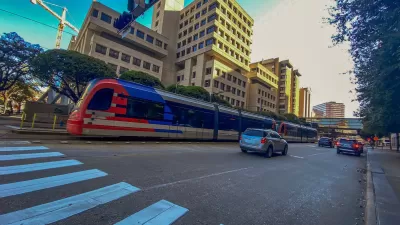Decaying and disused buildings litter many American inner-city neighborhoods. In Houston, one imaginative project turns potential into pride and empowerment by creating unique, new uses for old homes.
Switchboard's Kaid Benfield reports on an innovative project in Houston, in which old and disused row homes in one inner-city neighborhood have been transformed into community art space, as well as transitional housing. "I first discovered PRH four years ago," writes Benfield, "though the project was established back in 1993, on the site of 22 abandoned shotgun houses (circa 1930) in Houston's Third Ward. (Shotgun houses are narrow one-story dwellings without halls.)"
Twelve of the forty propoerties have been renovated into artist exhibition and/or residency spaces, with revolving exhibits showcasing African-American art and literature. Another seven have been transformed into transition housing for women.
"Nothing has been worse for our environment in the last several decades than the decay and disinvestment of our inner cities and accompanying suburban sprawl," says Benfield. "Strengthening the places we have before building new ones is critical to environmental recovery, and in my opinion doing so is inherently green whether or not we are able to add explicitly green features."
FULL STORY: Community art or community development? Yes and yes, in Houston's inspiring Project Row Houses

Americans May Be Stuck — But Why?
Americans are moving a lot less than they once did, and that is a problem. While Yoni Applebaum, in his highly-publicized article Stuck, gets the reasons badly wrong, it's still important to ask: why are we moving so much less than before?

Using Old Oil and Gas Wells for Green Energy Storage
Penn State researchers have found that repurposing abandoned oil and gas wells for geothermal-assisted compressed-air energy storage can boost efficiency, reduce environmental risks, and support clean energy and job transitions.

Placekeeping: Setting a New Precedent for City Planners
How a preservation-based approach to redevelopment and urban design can prevent displacement and honor legacy communities.

San Francisco’s Muni Ridership Grew in 2024
The system saw its highest ridership since before the Covid-19 pandemic, but faces a severe budget shortage in the coming year.

Colorado Lawmakers Move to Protect BRT Funding
In the face of potential federal funding cuts, CDOT leaders reasserted their commitment to planned bus rapid transit projects.

Safe Streets Funding in Jeopardy
The Trump administration is specifically targeting bike infrastructure and other road safety projects in its funding cuts.
Urban Design for Planners 1: Software Tools
This six-course series explores essential urban design concepts using open source software and equips planners with the tools they need to participate fully in the urban design process.
Planning for Universal Design
Learn the tools for implementing Universal Design in planning regulations.
Heyer Gruel & Associates PA
City of Moreno Valley
Institute for Housing and Urban Development Studies (IHS)
City of Grandview
Harvard GSD Executive Education
Salt Lake City
NYU Wagner Graduate School of Public Service
City of Cambridge, Maryland





























